As an Amazon Associate I earn from qualifying purchases.
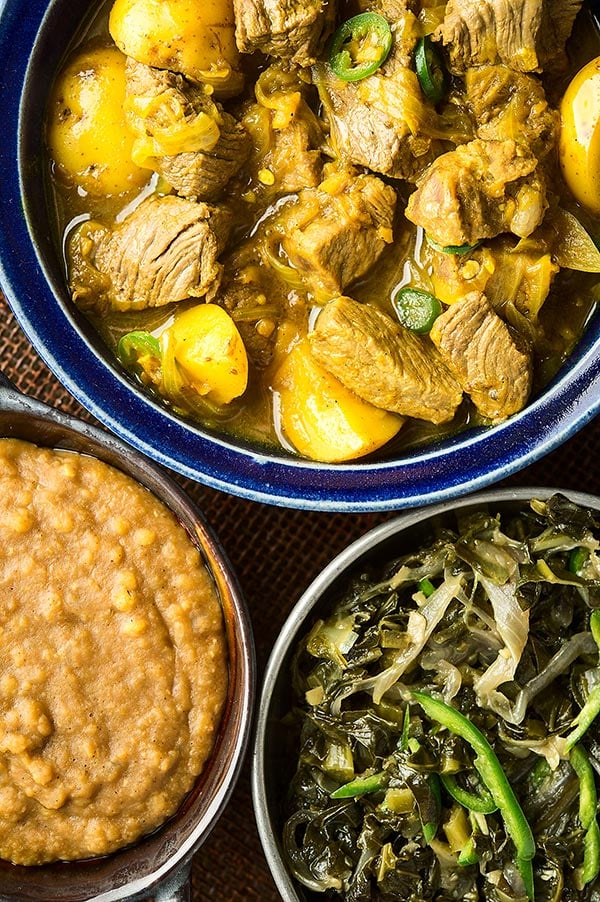
Alicha wot is one of those recipes from deep in the memory banks, back to 1993 when I worked at a restaurant called Horn of Africa in Madison, Wisconsin.
It was run by an Eritrean woman named Meselesh Ayele, and I came to be a cook there in the usual way: Hired as a dishwasher, our line cook skipped out one day and I was instantly promoted.
There are two main sorts of Ethiopian curries — and while they don’t call them curries, that’s what they are — red, intensely spicy ones, and yellow, not-quite-as-incendiary ones. This is the latter.
It’s called alicha wot, pronounced something like al-EETCH-a. Meselesh used to say this was the sort of food given to invalids, it was so mild. Given that chiles are not native to Ethiopia, and could have only arrived there sometime after 1500, and likely a century after that, I am amazed at how thoroughly the culture has adopted them. I can assure you this curry is not tame, if properly made.
Of course, you could make it so, by omitting all the chiles, but then the ghost of Meselesh (she died some years ago) would cackle down upon you, cigarette-hoarse and cutting.
It is a simple recipe. Lots of onions, garlic, ginger, meat. Our version always had potatoes in it, another New World adoption. I wonder what, if any, local tuber they would have used in Ethiopia?
The only odd ingredient, actually, is the butter you need to cook this stew in. Called niter kebbah, Ethiopian spiced butter is what makes their cuisine taste of itself. There is no substitute, but here is my recipe for niter kebbah, and, once made, it will keep for months in the fridge, or forever in the freezer.
I am using well-trimmed venison stew meat here, but we used either lamb or beef at the restaurant.
On a weeknight, you can serve your curry with rice. But if you want to really put on an Ethiopian spread, the side dishes really add a lot. I have some suggestions for sides in the recipe notes below.
If you love Ethiopian food, consider two other favorites from the Horn of Africa: doro wat, a spicy stewed chicken dish, and abish wot, a fenugreek-heavy stew made with beef, lamb, goat or venison.
Ethiopian Alicha Wot
Ingredients
- 1 large onion, sliced, about 3 cups
- 2 pounds venison stew meat, trimmed of silverskin
- 1/2 cup Ethiopian spiced butter (see notes)
- 2 tablespoons ginger, minced
- 5 cloves garlic, chopped
- 1 teaspoon turmeric, ground
- Salt
- 1 pound small potatoes, cut into chunks
- 4 serrano chiles, sliced thin
Instructions
- Add the onion to a large Dutch oven or other heavy pot and turn the heat to medium. Cook the onions dry, without fat, stirring often, until they soften, about 5 minutes.
- Mix in the venison stew meat. Add the spiced butter and brown the meat lightly, just about 5 to 8 minutes. Add the ginger, garlic and turmeric and mix well.
- Pour in about 5 cups water, enough to cover the meat by an inch or so, and simmer uncovered very gently for about 80 minutes. Add salt to taste during this time.
- Add the potatoes and simmer until they are tender, about 30 minutes or so. By now the stew should have thickened a bit. Stir in as many sliced chiles as you want and serve.
Notes
Nutrition
Nutrition information is automatically calculated, so should only be used as an approximation.
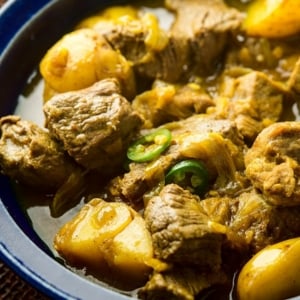

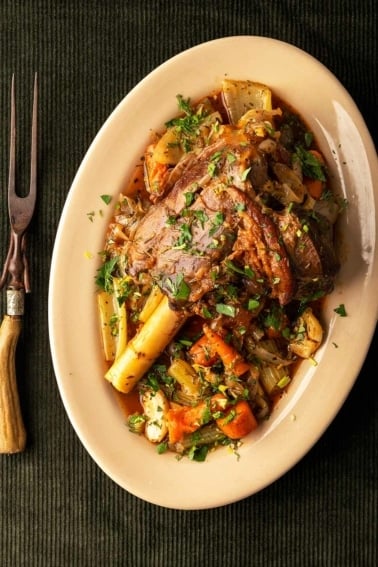
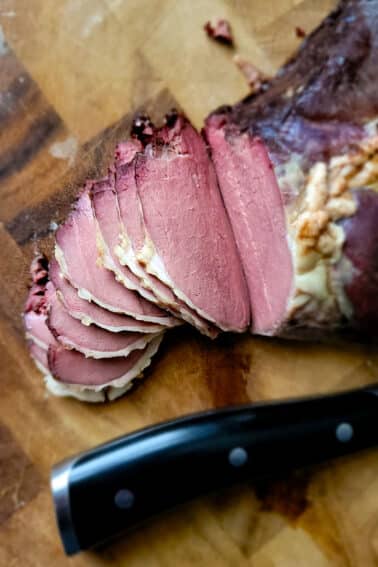
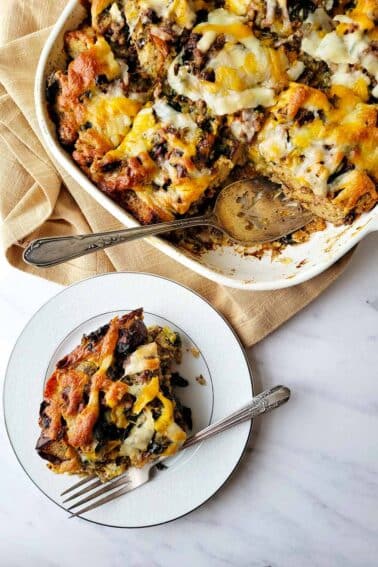
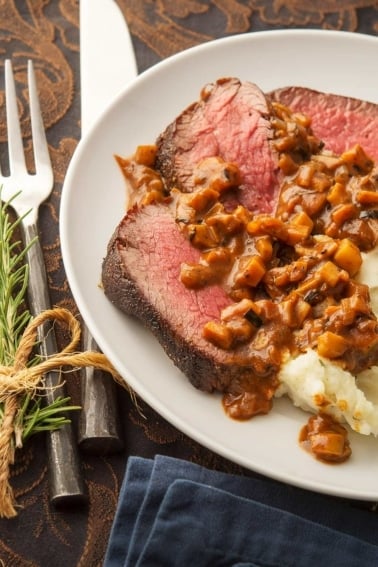
Made this without the potato but with some spinach thrown in. Absolutely amazing. Will make this on the regular
You have the names mixed together. Aliche means mild and Wot means spicy hot. So, if you were cooking lamb, it would be yebeg aliche if it was the mild version (usually with onion and mild pepper slices mixed in) and yebeg wot if it is the spicy red sauce that is cooked slowly and is about half red onions and half berbere pepper powder. I am starting some right now where I cook the lamb bones and fatty meat slowly to get a rich stock, and then I cook the onion and berbere together with tej and niter kebbeh separately for 2 days to make a very mello, deeply flavored sauce. After the bones and fatty pieces are simmered for half a day, I remove the bones and mix the stock into the onions and berbere sauce and continue to simmer for another day. When ready to serve, I sauté the chunks of leg of lamb that I seasoned in garlic salt, fenugreek, and some berbere and left in the fridge since I started the stock, then mix into the wot sauce and simmer for 30- 40 minutes. It is better than you can get in any of Washington DC’s Ethiopian restaurants.
What is even better than my yebeg wot is my venison kitfo. Since I hunt for meat and not for antlers, I shoot bambies or spike bucks (at the oldest). I make the traditional raw kitfo with ground bambi and it is sublime.
Made this with Chuck shoulder, tenderized the meat for two hours prior to cooking and it came out delicious. My Ethiopian husband gives it 5 stars and says it is the BEST. Thanks to Meselesh. May she rest in peace
Made Ethiopian Alicha Wot out of some aged cubed round steak from the Mule deer I harvested 3 weeks ago and what a treat! Making the spiced butter was fun and a neat intro to Ethiopian cooking. Like others I struggled to find Fenugreek in my spice pantry and didn’t have time to run to the store, I substituted w/ mustard seed toasted along w/ the other spices and it turned out great. Careful on the Serrano peppers as they will add some kick if they are hotter peppers. Another great dish from Mr. Hank Shaw and one that will go into the regular rotation at our house!
Which Ethiopian Restaurant made Venison Meat. Thanks
Tadesse: None, we used goat or lamb. But I am a hunter, so I use venison these days.
I love this recipe so much that I always keep niter kebbeh on hand. This recipe was my gateway drug to Ethiopian food. If you like this one, be sure to buy the new book, “Pheasant, Quail, Cottontail”, and make the Grouse Doro Wat. For that one, you’ll need to order some Berbere (check Amazon). You’ll soon find it becomes a staple in your pantry.
I made this last night with some elk stew meat. It was fantastic! I think the acidity of the ginger had an affect on the elk because it was muck more tender than it usually is after only two hours of stewing. I made the red lentils as well and they were a great compliment to the meal.
Made this tonight to test out. It was awesome! I had beef on hand so I used that instead of venison. And I added some asparagus and carrots to help clear out the refrigerator. The butter is unreal. Great work Hank!
Thanks for a great recipe. Made this tonight for dinner–subbed in chicken, as venison is not available here–and had some very happy eaters. My husband ate it without his customary hot sauce (only the second time I’ve ever seen him do so in our 5-year relationship), and my 3-year-old finished her seconds. Since I was raised vegetarian in a household where salt and spices were taboo, I absolutely loved this introduction to a new cuisine. Niter kebbeh is going to be a new resident in my secret ingredients cabinet. If you ever feel like posting other Ethiopian recipes, we are all ears!